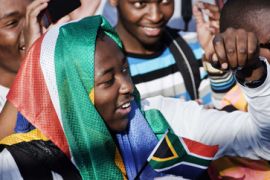Rugby in Soweto as Soccer City open
Main World Cup 2010 stadium gets first match while Super 14 arrives in black township.

 |
| The Soccer City stadium has seen its first professional match since re-opening [AFP] |
Two big matches in Johannesburg’s historic township of Soweto burnished South Africa’s “rainbow nation” image, scrambling the colour-code still often dividing sport.
Top-level rugby, traditionally the bastion of conservative white Afrikaners, came to Soweto on Saturday as one of South Africa’s top teams, Northern Bulls, took on Canterbury Crusaders of New Zealand in a Super 14 championship semi-final.
Meanwhile, the World Cup showpiece stadium Soccer City held its first professional match with the final of South Africa’s FA Cup, the Nedbank Cup, with AmaZulu of Durban facing Wits University of Johannesburg.
Sell-out crowds at both stadiums created a colossal traffic jam that forced a 30-minute delay in the kick-off for the football match, with the rugby scheduled to begin immediately afterwards in nearby Orlando Stadium.
With 76,000 fans packing into Soccer City and blowing long plastic vuvuzela trumpets, the noise was deafening as people danced in the stands, often in clown wigs dyed in national colours, and waving the South African flag.
“We’re proudly South African, so we are quite excited about the World Cup and we wanted to take part in this event,” said Louis Visser, a white fan who brought his wife and son to Soccer City.
Minority rule
Football was largely confined to townships under white-minority rule, which ended in 1994.
|
“It is one of those special South African moments that proves we are better off for having one another, and that despite the challenges we face, our society is on the right track” Archbishop Desmond Tutu |
The convergence of football and rugby fans of all races in South Africa’s most famous township, central to the anti-apartheid struggle, would have been unthinkable a decade ago.
“The last time white people in these numbers, and especially Afrikaans speakers, were ever in Soweto was in 1976 when the apartheid police force used light machine guns and automatic weapons to put down an insurrection of school children armed with stones,” said an editorial in the Star newspaper.
Archbishop Desmond Tutu called the Soweto match the most important development in rugby since the national team won the rugby World Cup in 1995.
That victory, and the politics of reconciliation that surrounded then-president Nelson Mandela’s support for the Springboks side, were the subject of the Clint Eastwood film “Invictus”.
“It is one of those special South African moments that proves we are better off for having one another, and that despite the challenges we face, our society is on the right track,” Nobel Peace Prize-winner Tutu said in a statement.
Bulls, once identified as the team of conservative white Afrikaners, were forced to find a new venue while their Pretoria home field readies to host football World Cup matches.
Symbol
The transformation of Loftus Versfeld, once seen as a symbol of apartheid, into a venue for the world’s largest football tournament underscores the change in South African sport.
But the absence of black faces in the Bulls’ starting line-up reminds of the legacy of sports segregation 16 years after the end of apartheid.
AmaZulu and Wits, the sides playing in the Cup final, have a handful of non-black players each, but also reflect football’s years of isolation as a black sport in South Africa.
Many Bulls fans had never stepped foot in Soweto, once home to Tutu and South Africa’s first black president Nelson Mandela.
“I am very excited. I’ve never been to Soweto, and I didn’t expect people to be so friendly. They showed us directions to get here when our bus got lost,” said Bulls fan Ben Tait from Pretoria.